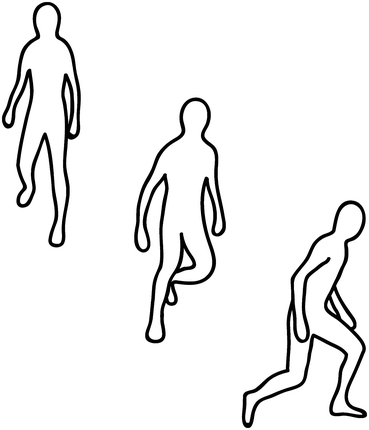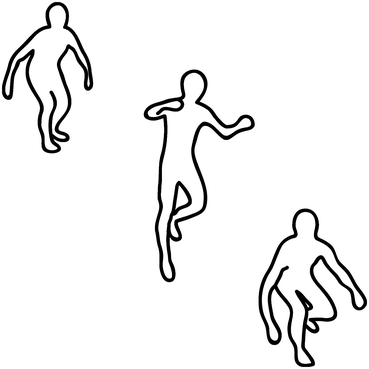Fig. 21.1
The drop vertical jump
The drop vertical jump/drop landing is composed of dropping off a box onto the ground (drop vertical jump/drop landing) and performing a vertical jump immediately after landing (drop vertical jump). In this task, subjects are instructed to stand on the box and drop off the box without jumping or stepping off (drop vertical jump/drop landing). As soon as they land on the ground, they are required to perform a vertical jump with maximal effort (drop vertical jump).
2.
The side-cutting task consists of an approaching run followed by a right or left landing on the ground and then changing direction to either the right or left at a designated angle. Prior to this task, subjects are usually instructed as to which direction they should execute the side-cutting maneuver with the reconstructed and contralateral limbs, unless the anticipated condition is necessary. The required approach speed is usually fixed at maximum speed to perform the task.
3.
The single hop maneuver consists of single-limb jumping and landing on the ground with the same limb. Subjects are instructed to stand on a single leg at the starting position and jump as far as possible. They then land on the same limb and maintain a stable lower limb. In general, the subjects are not instructed to perform any upper limb movements (such as swinging the arms) during this task.
21.4 Kinematics and Kinetics Representing Biomechanical Adaptations
Joint mechanics include kinematics and kinetics that are calculated using the three-dimensional coordinate system and inverse dynamics approach.
With regard to landing patterns, the altered loading strategy and joint movements on the reconstructed limb are typically present, and reveal that the hip and ankle joints compensate upon the loading absorption of the initial contact (Decker et al. 2002). Asymmetries between limbs in sagittal plane knee moments are also present (Paterno et al. 2010). The time-course changes in the lower kinematics upon landing indicate that the hip is likely to be more extended and the ankle is more plantar-flexed during initial contact (Decker et al. 2002). Following initial contact, the ACL-reconstructed subjects tend to exhibit a more adducted hip position and a less adducted and flexed knee position (Delahunt et al. 2012).
In the side-cutting maneuver, in which the athlete is required to first make a stable landing and then execute a side cut, increased knee abduction angles occur knee adductor moments on the reconstructed limb were also observed during the first 20 % of the stance phase defined as the early deceleration phase (Stearns and Pollard 2013). Decreased initial knee flexion velocity on the reconstructed limb was also observed upon landing (Dai et al. 2012). It has also been demonstrated that asymmetries in sagittal plane knee moment are associated with asymmetries in the vertical ground reaction force. Thus, compensation strategies in side cutting may exist in ACL reconstructed subjects (Dai et al. 2013).
In the single hop maneuver, which requires trunk and lower limb stabilization for takeoff and landing, decreased range of motion at the hip, knee, and ankle were observed, and the knee flexion angle was less on the reconstructed limb at the initial posture takeoff posture (Gokeler et al. 2009) and at landing (Orishimo et al. 2010). A low peak-knee extension moment and peak power on the reconstructed limb, and high peak hip and ankle extension moments and power were observed at takeoff (Orishimo et al. 2010). Peak power, considered as force absorption during landing, on the reconstructed limb was also low at the knee and high at the hip and ankle at landing (Orishimo et al. 2010). A low knee extension moment tends to be primarily compensated by the ankle joint (Gokeler et al. 2009).
Altered sagittal and frontal plane of lower limb joint mechanics are commonly observed after ACL reconstruction during introduced dynamic exercises, and these alterations have been considered critical risk factors for secondary ACL injury. Sagittal and frontal plane kinematics and kinetics as well as postural stability are key factors in the evaluation of the physical characteristics of ACL-reconstructed subjects and important predictors of a secondary ACL injury after ACL reconstruction (Hewett et al. 2012; Paterno et al. 2010).
21.5 Current Views in ACL-Reconstructed Subjects
Altered lower limb joint mechanics on the reconstructed limb during dynamic exercises are commonly observed after ACL reconstruction. A combination of deceleration and acceleration with high velocity is a frequent requirement in many sports. These movements have a major effect on loading strategies and joint movement patterns and increase the risk of secondary ACL injury. To prevent a secondary ACL injury, rehabilitation programs after ACL reconstruction need to include restoration of the proper lower limb movement patterns, especially at landing, before the subject returns to sports participation. Proper lower limb alignment enables the encountered forces to be properly transferred to the joints, which should be one of the goals after ACL reconstruction, both to enhance performance and to prevent a secondary ACL injury.
In the clinical setting, recovery tends to be focused more on clinical performance tests which evaluate the strength of the muscles around the knee joint as well as agility variables which are measured in time and distance (Czuppon et al. 2013; Thomee et al. 2011). Although conducting these tests does not require special measurement equipment and the tests are easily performed in clinical settings, outcomes from these tests depict only performance results; compensatory adaptations that allow a good performance but increase the risk of a secondary ACL injury may be masked. The relationship between clinical outcomes and laboratory-based outcomes should be taken into account when evaluating ACL-reconstructed subjects who have biomechanical impairments. In most cases such assessments should take place before the athlete returns to sports participation.
In addition to biomechanical adaptations, adaptations in muscle activity, particularly in the onset times and in peak activity, are also commonly seen during dynamic exercises after ACL reconstruction (Coats-Thomas et al. 2013; DeMont et al. 1999; Gokeler et al. 2009; Swanik et al. 1999). In dynamic exercises, the primary function of muscle is to stabilize the joints by generating force (Gokeler et al. 2009; Solomonow and Krogsgaard 2001). Deficits in neuromuscular function and dynamic strength as well as the inhibition of muscular exertion, however, may create a situation where the muscles cannot absorb the required loading and subsequently prepare the joint for ground contact that provides for a proper lower extremity alignment. This may lead to compensatory movement patterns in lower limb joints on the reconstructed limb that result in altered kinematics and kinetics.
In this chapter I have evaluated the use of dynamic exercises to assess biomechanical adaptations and described the biomechanical characteristics observed in ACL-reconstructed subjects after ACL reconstruction. Although it is unknown which risk factors are strongly associated with a secondary ACL injury, adequate intervention strategies are needed to eliminate risk factors, restore optimal function, and enhance performance. Further studies are needed to simultaneously investigate both biomechanical and neuromuscular adaptations that increase our understanding of the mechanisms that underly secondary ACL injuries.
21.6 Limitations
A limited number of studies, often with a small sample size, were available for the review performed in this chapter. In addition, the review involved a summary of ACL-reconstructed subjects who were not differentiated according to surgical technique, time since surgery, age, or sex.
Stay updated, free articles. Join our Telegram channel

Full access? Get Clinical Tree










